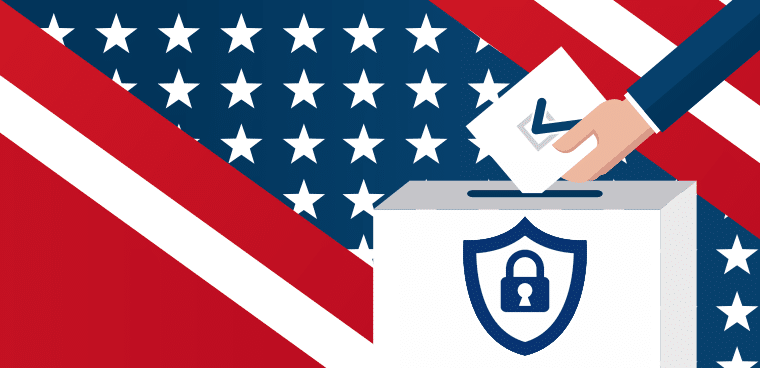PRINCETON, N.J. (For immediate release) – Cybersecurity expert Milan Baria shares important guidance on upcoming presidential election
This presidential election may feel like a mass of confusing and contradictory information to many American voters.
In many ways, it is.
Threats of foreign meddling. Partisan exaggeration in print, broadcast and social media. An incumbent already casting doubt on election results. The continuing threat of COVID-19 driving more mail voting than ever before. A loss of trust in formerly stalwart sources of information.
And now emails from servers in foreign countries threatening voters in at least three states with retribution if they don’t vote for President Trump.
Three of four American adults fear foreign governments will try to influence the election, according to a Pew Research Center survey.
Experts validate the concern.
“I believe we are more vulnerable to online disinformation from foreign and domestic sources than ever before,” says Nina Jankowicz, a disinformation expert at the non-partisan Wilson Center who recently testified before the House Permanent Select Committee on Intelligence.
Troubling times.
But let’s leave the hand-wringing to others and focus more on who we are and what we can do.
We are a democratic republic with an historic ability to hold fair elections and stand up to threats to our democratic process. Through wars, economic strife and social upheaval, we have successfully elected our representatives by taking personal responsibility to be informed voters.
To gather facts yourself:
- Be aware of fake websites. Check the byline or news source in a search engine before clicking on the story. Some social media sites include an icon such as a white checkmark in a blue cloud to show validated sources.
- Don’t share on social media anything you haven’t read and confirmed.
- Be suspicious of undated stories. Juicy rumors often resurface, even when debunked (faked moon landing, anyone? How about “Pope Endorses Trump”?).
- Read beyond headlines, which often are clickbait and don’t reflect content.
- Investigate suspicious images and videos. Use sites such as CitizenEvidence or add a plug-in, such as InVid (Chrome or Firefox), to validate videos and images.
- Check facts using reputable websites: the U.S. Cybersecurity & Infrastructure Security Agency, FactCheck, Snopes or PolitiFact, among others.
- Respect your workplace’s cybersecurity policies when viewing election-related information, and don’t expose your company to hackers by opening emails or attachments from unknown senders.
Let’s face it, dirty tricks and misinformation have been part of elections since the nation’s founding.
George Washington left the presidential office in 1797 saying, he was tired to being buffeted “in the public prints by a set of infamous scribblers” from partisan newspapers.
During the 1860 presidential campaign, a Democratic newspaper reported rumors that Republican candidate Abraham Lincoln had died.
Lincoln, himself, wasn’t above using partisan newspapers – the dominant although not very timely medium of the day – to level baseless accusations against his opponents when he ran for the Illinois legislature.
Even the term “fake news” isn’t new. It was first used by the Buffalo Commercial newspaper in 1891 to assert that readers wanted facts and had “no genuine appetite for fake news.”
We are exposed to more than our share of misstatements today because we have so many information options. The speed of news and information has increased by light years from the days of the printing press.
With each technological advance, many have worried about undue influence and incorrect information. But it always seems to work itself out.
When radio was the social media of its day, political groups in the 1920s worried about unchallenged assertions being broadcast – and they were. But we adjusted and sorted out the information.
In 1952, national television networks began reporting returns as soon as polls closed on the East Coast. Political parties worried it would suppress turnout in the later time zones. Fact or fantasy? We still don’t know for sure.
Today, we get returns on our smartphones and email alerts on our watches.
We should be more informed than ever, but many of the technology advances have sown mistrust. News changes quickly. Social media posts are up, then taken down, revised and reposted; given credibility because of algorithms that measure a post’s popularity (times viewed, shared or commented on) but don’t assess its accuracy.
A University of Oxford Reuters Institute study found 27 percent of its respondents worried about the accuracy of a story on a blog, but 40 percent believed blogs were more balanced than print stories.
“There has been more new error propagated by the press in the last 10 years than in a hundred years before.”
President John Adams said that. In 1798.
No matter your position, please be sure to vote.
-0-
Milan Baria is CEO of Princeton-based Blueclone Networks a NJ Computer Support & Cyber Security firm. He has appeared on network television as a cybersecurity expert, and is co-author of the Amazon best-seller “You Are The #1 Target: Why Your Business Is Likely To Be The Victim of Cybercrime Now More Than Ever Before…And What You Can Do To Stop It.”
About Blueclone Networks
Blueclone Networks is a business technology advisor and managed services provider in Princeton, N.J. providing computer services, cloud apps, VoIP, a 24/7 helpdesk, and cybersecurity services to SMBs, and co-managed IT services to enterprise-level organizations. Blueclone’s primary initiative is to keep clients safe and ensure organizations can meet and demonstrate regulatory compliance.
This first appeared on www.blueclone.com





